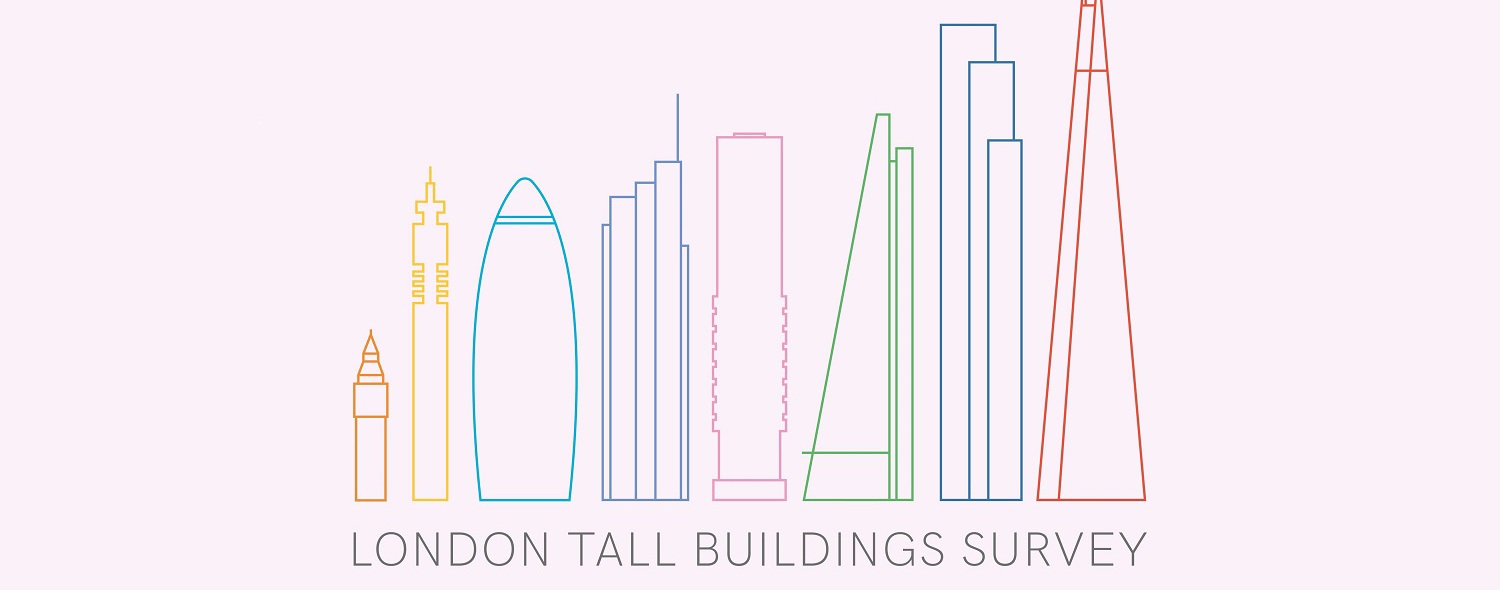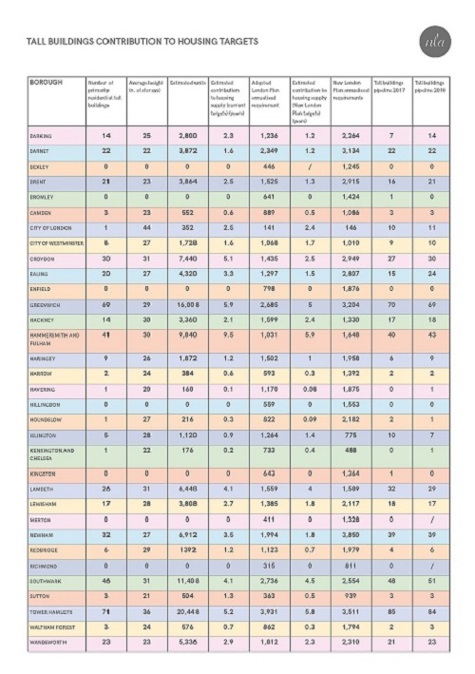
New London Architecture declares 2019 "The Year of the Tall Building"
PR Contacts
For press enquiries please contact:
05 March 2019
New London Architecture (NLA) has announced the results of its sixth London Tall Buildings Survey, capturing the capital’s changing skyline. With GL Hearn as research partner, the study provides the only comprehensive analysis of all tall buildings, over 20 storeys, which are proposed, in planning or under construction in London.
New London Architecture (NLA) and GL Hearn’s Annual London Tall Buildings Survey, now in its sixth year, shows that tall building delivery in the capital is at its highest point in history.
- A record number of 76 tall buildings set to be completed in 2019, a three-fold increase on 2018.
- The current pipeline now stands at 541 buildings for the year 2018, up from 510 in 2017.
- 22 out of the 33 London boroughs now contain tall buildings under construction, including newcomers Camden, Barnet and Hounslow.
- These tall buildings will provide more than 110,000 new homes, meeting a major part of London’s housing need.
- Survey released ahead of GLA examination of Tall Buildings as part of the New London Plan on 6 March.
The findings published today (5 March 2019) for 2018 show that tall building delivery in the capital is at its highest point in history, with up to 76 tall buildings set to be completed in 2019, a three-fold increase on 2018. There has also been a significant increase in the permission rate, increasing to 291, from 267 in 2017.
The report shows London now has 541 towers in the pipeline, up 6% from 2017 (510) and a record number of 121 schemes are under construction, compared to 115 in 2017, with the majority due for completion in 2019. Since the first report in 2014, 147 tall buildings have been completed, so the surge in completions expected in 2019 would mark a significant shift in the role tall buildings play in the Capital.
23 out of the 33 London boroughs now contain tall buildings under construction compared to 20 last year, including newcomers Camden, Barnet and Hounslow. There was a significant increase in outer London boroughs, with 5% more tall buildings in the pipeline compared with 2017. Of these, Barking & Dagenham (+100% / +7), Brent (+30% / +5) and Ealing (+60% / +9) had the most noticeable changes from 2017 to 2018
90% of all tall buildings proposed are for substantially residential use, estimated to deliver in excess of 110,000 new homes for London, equivalent to almost two years’ of total housing supply needed based on the Mayor of London’s target for 60,000 additional homes per year.
The survey did show a very slight slowdown in the number of applications and starts on site in 2018, respectively down 3.8% and 2% from the previous year, suggesting that despite the economic and political uncertainties around Brexit, the appetite for tall buildings in the capital is stable.
The survey is released just a day ahead of the GLA’s examination of Tall Buildings as part of the New London Plan, which is scheduled to take place tomorrow, 6 March 2019.
Peter Murray, Chairman of New London Architecture said:
“After six years of undertaking this review, I think we can finally declare 2019 as the Year of the Tall Building.
“Tall buildings are becoming increasingly accepted as a necessary form of urban development, not just in commercial centres like the City or Canary Wharf, but to provide much needed new homes right across the Capital. This year’s research confirms that tall buildings are now an established component of London’s development programme; in spite of the current political uncertainty the pipeline remains steady.
“Whilst there is increased acceptance on tall buildings to meet this need, for us the importance has to be on the design quality of tall buildings, both in their impact on the skyline and how they interact with the environment at street level.
“The NLA continues to call for the greater use of computer modelling by planners to assess the impact of taller buildings and once again this year we have worked closely with VU.CITY, whose London model is the largest, most accurate digital model in the world, to produce projected imagery.”
Stuart Baillie, Head of Planning (London and South East), GL Hearn said:
“This year’s survey demonstrates that there is continued appetite for tall buildings in London. East London continues to be a focus and outer London is seeing a growing share of the pipeline albeit focused on seven outer London boroughs.
“Politicians and planning policies appear to be facilitating this growth with a fairly consistent number of applications over the last two years but notably an increase in planning permissions and only eight refusals in 2018.
“The projected completion of 76 tall buildings during 2019 is quite staggering compared to previous years’ completions being less than 30 per annum.”
Jules Pipe, Deputy Mayor for Planning, Regeneration and Skills, at the GLA, said:
“London continues to grow and with this comes a number of challenges. The Mayor and I are clear that, when located in the right place and designed with their surroundings firmly in mind, tall buildings have a role to play in meeting the needs of our rapidly expanding city, by providing much-needed homes and space for businesses.”
The table below illustrated the borough breakdown of tall buildings. Boroughs experiencing most construction activity continue to be Lambeth, Tower Hamlets and Wandsworth, all having the same number of buildings under construction as in 2017, where construction of large schemes such as Heron Quays West and Wood Wharf progresses. The overall increase in construction activity on tall buildings is led by Brent (+2), Croydon (+3), Ealing (+3) and Hammersmith & Fulham (+3). Whilst Hammersmith and Fulham is one of the most active boroughs for tall buildings, they only saw one completion in 2018.
Greenwich only saw completion of two tall buildings as part of the Greenwich Peninsula proposals, which have driven tall buildings activity in the borough since submission in 2015. Ealing will see the largest percentage increase with an 1100% increase in tall buildings, the borough only has 2 tall buildings currently but could see another 24 built in coming years.

As part of the survey launch the NLA will be hosting an exhibition, London Tall Buildings 2019, open from
5 March - 30 April, looking at the key 100 tall building projects that are in delivery or that have been delivered in the past five years, showcasing their scale, mix of use and offer to the city through public space, ground floor use and material quality. In addition, on the 28 March 2019, a half day conference examining London’s changing skyline, will be hosted at the Building Centre.
The NLA London Tall Buildings Survey 2019 is available to download here.
- Share
PR Contacts
For press enquiries please contact:
This year’s survey demonstrates that there is continued appetite for tall buildings in London. East London continues to be a focus and outer London is seeing a growing share of the pipeline albeit focused on seven outer London boroughs.

